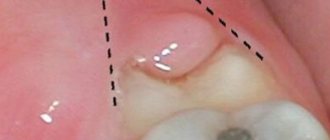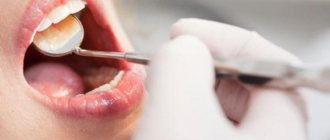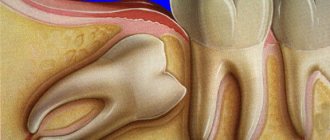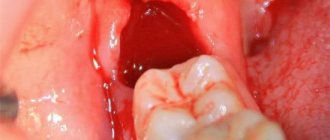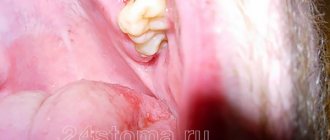From this article you will learn:
- whether wisdom teeth are treated or removed,
- indications and contraindications for treatment,
- Is it possible to remove a wisdom tooth - while it has not yet erupted.
Wisdom teeth are called eighth teeth - according to the serial number in the dental formula (counting is from the central incisors, respectively, for each half of the dentition of the upper and lower jaw). There are four wisdom teeth in total, and they always begin to erupt in the jaw later than all other teeth in the permanent dentition - usually between 18 and 21 years, although in some cases this can happen at 14 years, and even after 40 years. Is it necessary to remove wisdom teeth since they cause so many problems for most of their owners?
To remove or treat a wisdom tooth is determined in dentistry according to a number of criteria. For example, the most important of them is whether there is enough space in the dentition for their normal eruption. After all, for example, if the length of the lower jaw is insufficient, then the lack of space in the dentition will certainly cause their difficult eruption, accompanied by inflammation of the gums and pain. But that's not all, because... the constant pressure of a wisdom tooth trying to erupt on the 7th tooth in front is highly likely to lead to displacement of the teeth and the occurrence of crowding in the anterior sections of the dentition.
Eruption of wisdom teeth –
But very often the question: is it worth removing wisdom teeth - is asked in relation to already erupted, for example, partially destroyed eighth teeth. Whether such wisdom teeth are treated depends, for example, on the correct position of the tooth in the dentition, or on the presence of an antagonist tooth (with which the closure occurs), etc. Moreover, the opinion of dentists of different specializations may differ radically. For example, when you visit a dental surgeon, the doctor may immediately recommend that you remove it, just so as not to sit idle. The same applies to dental therapists.
It is best for the decision on the need to remove or treat a wisdom tooth to be made by an orthopedic dentist (prosthetist), because the most important thing is to make this decision precisely from the point of view of the need for this tooth for prosthetics in the future. As for the issue of removing figure eights if their eruption is difficult, it is advisable that such a decision be made by an orthodontist. Because, again, when you have an appointment with a dental surgeon, often such doctors do not even look at the length of the jaws, but immediately recommend removing the eights, although they could have erupted quite normally.
Content
- Reasons for the development of pathology
- Which doctor should I contact if my tooth has chipped?
- Activities before visiting the dentist
- Microprosthetics
- Place a crown on a chipped tooth
- When is implantation necessary?
Tooth decay is an unpleasant event that requires immediate response. This can happen due to injury, untreated caries, brittle teeth and other reasons. Any chips, even small ones, mean a violation of the integrity of the enamel. That is, the tooth becomes vulnerable, infection can enter and the destruction of the crown part can continue. The patient begins to feel discomfort and pain when exposed to hot and cold temperatures, sweet and sour. The sharp edge of the chip injures the soft tissue of the gums during chewing, and bacteria penetrating into the wound cause inflammation. To restore your tooth and avoid negative consequences, you should immediately make an appointment with a specialist.
Who will have to part with a tooth?
Complications following tooth extraction in the doctor's office are extremely rare. Much more often, sad consequences occur when it spontaneously falls out due to destruction or injury. In such cases, there are two options: restoration of dentin and enamel or removal of the tooth root.
The tooth root will have to be removed if the following symptoms occur:
- constant discomfort in the gums;
- sharp pain when chewing;
- swollen soft tissue;
- bleeding;
- the appearance of pus.
A sure sign of an inflammatory process in the gums is an increase in body temperature in the absence of symptoms of another disease.
Important! You cannot postpone a visit to the dentist, even if only one of these symptoms appears. Any suspicion that the tooth root remains in the gum and has begun to rot should prompt an urgent visit to a doctor.
What are the roots of teeth, look at the photo:
Temporary contraindications
Surgical removal of the root of a decayed tooth is contraindicated during:
- relapse of complex mental disorder;
- acute phase of ARVI;
- exacerbation of neurological disease;
- rehabilitation after a heart attack.
Doctors at dental clinics are aware of all contraindications to extraction. But not all conditions have clear clinical signs, so in order to avoid unpleasant consequences, it is necessary to warn the doctor about the ailment.
Reasons for the development of pathology
Damage can be caused by several direct or indirect factors. Determining the cause is an important aspect for proper treatment. Among these factors:
- Mechanical damage due to trauma.
- Chipping due to bad habits (biting nails, pens, and other objects not intended for this purpose).
- Reduced acidity of the oral cavity, which negatively affects the strength of enamel.
- Bite defects.
- Dental pathologies that have not received treatment.
- Remineralized enamel.
- Hormonal imbalances, changes during pregnancy.
- Frequent consumption of excessively hot or cold foods.
- Night grinding of teeth.
Possible causes of chipping
Caries is one of the most common causes of enamel destruction. In the case of eights, the risk of developing carious processes will be significantly higher, which is primarily due to their anatomical features and problematic growth. The sixth molars often grow crookedly and put pressure on their “neighbor”, and due to the dense gingival hood on top, this whole process is accompanied by inflammation and even suppuration of the mucous membrane.
This is the very last tooth in the row, it has the largest and widest crown, and its growth process can last for years. Bacteria inevitably accumulate in places that are difficult to clean, including under the gums, and plaque and deposits form.
Among other possible causes of damage, dental experts identify acute demineralization of hard tissues due to vitamin deficiency, systemic diseases, and weakened immunity1. Another possible reason is constant traumatic impact due to malocclusion, incorrectly installed filling, crown or prosthesis, due to bruxism - involuntary grinding of the jaws during sleep, which leads to pathological abrasion of the enamel.
Regardless of what exactly triggered the injury, you should seek advice from a specialist as soon as possible. The damage itself and the cause of its occurrence must be eliminated, otherwise the defect can lead to the development of complications.
Caries is one of the most common causes of enamel destruction
Activities before visiting the dentist
Depending on the extent of the damage, the patient may feel discomfort from increased sensitivity and pain. If a sharp edge is formed after the chipping, it will scratch the gum, tongue, and cheek. Such damage is a favorable environment for infection. The sharp edge must be isolated as soon as possible. A tooth that has lost full enamel protection is also vulnerable to infection.
While waiting for a visit to the dentist, the patient can take a number of actions to minimize negative consequences:
- Do not put any pressure on the affected tooth or chew hard food on its side.
- Thoroughly clean the chipped area, avoiding the accumulation of food debris and plaque.
- Rinse with a soda solution (you can add iodine and salt).
- If your chipped tooth hurts, you can take a pain reliever.
PROMOTION
Hygienic teeth cleaning
2000 rub.
Wisdom teeth diseases
Most often, third molars suffer from caries, since due to the inconvenient location of the “eights” in the mouth, it is extremely difficult to take good care of their hygiene. A carious cavity usually occurs in an area that is difficult for the dentist to reach, so treatment is not always possible. If the doctor understands that it will not be possible to get close to the affected area and fill the tooth properly, he suggests removing the third molar.
At the same time, it is important to understand that you should not delay going to a specialist if you notice any problems with the G8. Untreated caries may well develop into pulpitis and even periodontitis, which will require a definitive tooth extraction.
Microprosthetics for tooth restoration
To restore the aesthetics and full function of a damaged tooth, restoration is used. If the chip is small, the problem can be solved using composite materials. For more significant damage, microprosthetics would be an excellent option. Inlays, which serve as microprostheses for restoring teeth, are made from composite materials based on an impression. They are durable and aesthetic, and are widely used in modern dentistry.
Micro-prostheses also include veneers. These are thin plates that are attached from the outside to the prepared teeth (in the frontal zone of the dentition, covering the front part and lower edge of the tooth). Veneers are also made from impressions and are effective in correcting most aesthetic problems. The plates are mainly made of ceramics and zirconium dioxide.
If the injury affects the pulp, the specialist treats the canals, and then fills or installs a microprosthesis.
Indications for removal
In some circumstances, removing the “eight” becomes the only way out. In particular, the doctor will decide to get rid of the eighth tooth if:
- It is located at an angle and when cutting through it puts pressure on the roots of its neighbors;
- A partially erupted tooth injures the gums;
- When affected by caries, the treatment area is difficult to reach;
- The roots of the "eight" grow in the maxillary sinus;
- The patient suffers from facial neuralgia;
- Complications developed;
- There is a gum cyst in the eruption area.
Installing a crown on a chipped tooth
In case of significant injuries, if it is impossible to restore the crown part of the tooth, a new tooth can be obtained using prosthetics. The prosthesis - crown - is fixed on the root of the tooth if this part remains healthy and strong. Different types of crowns are used depending on the material of manufacture:
- Metal ceramics are the most inexpensive option. The design is durable due to the metal base, and aesthetic due to the ceramic layer. Such dentures become an ideal option for budget restoration of teeth in the chewing area. Installation of metal ceramics in the frontal area is possible, but the tooth will not look natural due to the lack of transparency.
- Zirconium dioxide is a modern high-tech material that has both the strength and aesthetics of natural teeth. Such crowns are made using computerized technology and are practically indistinguishable from natural teeth in appearance. They refract light correctly and have a certain degree of transparency, similar to tooth enamel.
- Ceramic crown. This option is only suitable for the front teeth, since the structure is not strong enough to withstand the full chewing load. Ceramics look very aesthetically pleasing.
What to do after deletion
After any surgical intervention, you should follow all the dentist’s recommendations, as well as:
- do not eat for 2 hours after the procedure;
- cool the soft tissues of the face in the projection of the removed root;
- stop smoking for two days;
- take prescribed pain medication;
- make antiseptic applications;
- watch to see if other teeth are crumbling.
Sometimes after complex extractions, dentists prescribe antibiotics to patients.
This appointment cannot be ignored - after a tooth is pulled out of the socket, a focus of infection forms in it, which can only be extinguished with the help of medications.
The following video schematically shows different methods for removing incisors, canines, molars and premolars of the lower and upper jaw.
When is implantation needed?
Implantation is required if the root part of the tooth is damaged and cannot be used as a support for a prosthesis. This can happen when the side wall of the tooth is broken (below the gum level), deeply damaged by caries, root fracture, etc. In these cases, the tooth is completely removed and replaced with a titanium rod - an implant. Crowns are also placed on implants. These are metal ceramics and zirconium dioxide; ceramic prostheses are not used due to their high fragility.
Generalized scheme for tooth extraction
The process of removing any tooth includes the following steps:
- Examination and collection of anamnesis (allergic status, information about the state of health and the dental apparatus).
- Preparation of the surgical field: treatment of the injection site, rinsing the mouth with an antiseptic.
- Anesthesia.
- Detachment of gum from tooth using a trowel.
- Loosening a tooth with forceps.
- Extracting a tooth from its socket.
- Treating the hole with an antiseptic.
- Stop bleeding with tamponade.
According to this scheme, simple removal is carried out. In some situations, for example, when a wisdom tooth or a badly damaged molar is pulled out, a complex extraction is required. Its main difference is that in addition to forceps, the dentist uses a drill to cut out bone tissue or saw the root into pieces, a chisel, a hammer and other dental instruments.
Wisdom tooth removal diagram
Getting rid of a wisdom tooth can be especially difficult. Due to its location in the posterior quadrant of the jaw, access to it is difficult. With anatomically incorrect or curved roots, which are often found in third molars, the dentist may be forced to make incisions in the gums, pull out the root piece by piece, and then apply sutures.
Prevention of dental diseases
A number of simple steps will help the patient keep his teeth healthy for as long as possible and reduce the likelihood of diseases:
- Careful hygiene, brushing teeth at least twice a day.
- Using dental floss and rinsing with special solutions.
- Attention to the condition of soft tissues and gums.
- Timely visit to the dentist if alarming symptoms appear, preventive examinations twice a year.
How to pull a tooth at home without pain
How to relieve toothache at home
What complications can there be?
The gradual destruction of the figure eight inevitably leads to the development of inflammatory processes, because a crown with large chips quickly becomes a breeding ground for harmful bacteria. In this case, the damage rapidly spreads deep into the hard tissues, moving to dentin and pulp. This situation is fraught with the appearance of acute symptoms: severe pain and the onset of suppuration processes. Urgent removal of the causative element is required, but such conditions significantly complicate the doctor’s task. If the cause is caries, the pathology can easily spread to the adjacent molar and lead to its destruction.
